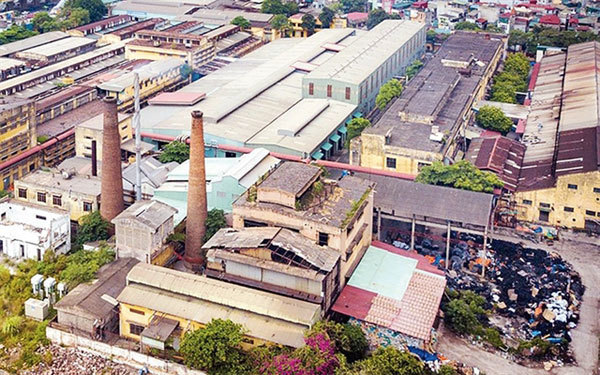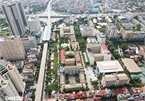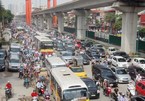 |
| Sao Vang Rubber Factory in Thanh Xuan District. Photo nhandan.com.vn |
However, the relocation process has been delayed for many years, leaving central Hanoi exposed to the downfalls of rapid urbanisation.
Transport infrastructure has not been developed synchronously and planning of public works, green spaces and the school system has been below par.
In March, Hanoi’s People’s Committee approved six urban planning for the four core inner-city districts of Hoan Kiem, Ba Dinh, Hai Ba Trung and Dong Da.
The planning projects on 2,700ha aims to reduce the population to 672,000 people from 1.2 million people in the four districts and improve the social and technical infrastructure of the city.
Hanoians have long been waiting for concrete measures from the municipal government to bring planning to life, especially the relocation of universities, hospitals and polluted production facilities to overcome environmental pollution, traffic jams ad save land for public spaces.
“This was a very good policy. I, like many people, expected the project to be realised soon,” said Vo Thi Hue, a resident in Hai Ba Trung District’s Vinh Tuy Ward.
“The fact that industrial production plants were located in densely populated residential areas in central districts was completely inappropriate, it was necessary to quickly find solutions to bring them out of the inner city,” said Hue.
In Vinh Tuy Ward, Dong Xuan Knitting Company still maintains some production units which cause smoke and dust pollution for residential areas nearby.
Local people have petitioned authorities many times but the company was not relocated even after it built a new factory in Hung Yen Province and put it into operation.
Vu Ngoc Quy, a resident in Dong Da District’s Kim Lien Ward, said to reduce traffic pressure in the four central districts with a very large population, moving universities and hospitals to the outskirts is a sound policy.
A policy to relocate the headquarters of ministries, branches and central agencies out of Hanoi’s inner city was approved in a Government resolution in 2008.
In January 2015, then-Prime Minister Nguyen Tan Dung issued Decision No 130/QD-TTg on measures, the relocation schedule and the use of land in central districts after the relocation of industrial production facilities, hospitals and higher education and vocational training establishments.
However, out of nine ministries, branches and central agencies that have completed construction investment and moved to work at new headquarters, only one handed over its old headquarters.
As for universities and colleges, there are 26 establishments in the four central districts, but so far, only the University of Community Health in Ba Dinh District has relocated.
As for polluting establishments, in 2016, the Capital Law determined the roadmap for relocating 117 establishments in 12 districts out of the inner city by 2020.
However, the relocation work has been virtually stagnant.
A representative of the Hanoi Department of Natural Resources and Environment said the department has been reviewing and adjusting facilities that have to be relocated after the approval of the six residential planning projects.
Recently, the Ministry of Construction acknowledged relocation was very necessary. However, the organisation and implementation of relocation were still slow.
According to the ministry, there were many reasons leading to this situation such as changes in guidelines, policies and laws affecting the progress of planning and relocation projects.
The implementation process encountered many difficulties in mobilising resources and arranging capital while relocation requires huge budgets.
In addition, the initiative, co-ordination and implementation work from agencies was not sufficient.
Dr Dao Ngoc Nghiem, vice president of Vietnam Urban Development Planning Association, said one of the reasons ministries and branches were slow to move to the suburban areas and hand over the land to Hanoi authorities was because they were entangled in the Land Law.
“Because this law regulates that headquarters of ministries, branches, industrial establishments, universities, etc., are allocated land for a definite time and within the allocated time limit, they have full rights to use and exploit the land,” said Nghiem.
“Therefore, many units have kept the old headquarters despite being allocated land to build new ones because they are still within the time limit for land allocation,” he said.
“Thus, Hanoi needed a specific mechanism to revoke the land soon after the units relocate. At that time, the urban areas would have more favourable factors to solve problems such as population expansion and additional land for infrastructure development,” he said.
To hasten the relocation of industrial production facilities, the Hanoi People's Committee has established a steering committee for relocation, built a list of works that need to be relocated and proposed criteria and roadmaps for relocation in 12 inner-city districts, according to the Ministry of Construction.
For the relocation of medical, education and training facilities, the Ministry of Health and Ministry of Education are implementing separate planning programmes on their relocation.
According to Nguyen Duc Hung, vice director of Hanoi Planning and Construction Institute, one of the most important goals of the zoning plan of the historic inner city districts was to relocate the headquarters of ministries, branches and universities.
“At that time, it would create a land fund of about 176ha to build public works and green spaces that is now very lacking, and moving about 100,000 people out of the areas,” Hung said.
“However, the actual implementation is not simple. Along with Hanoi’s responsibility, the drastic participation of all levels, branches, the whole political system is needed with high determination to soon achieve the goals,” he added.
Source: Vietnam News

Sluggish university relocation worsens Hanoi traffic
The plan to relocate many universities from central Hanoi areas has remained committed to paper, with this being blamed for worsening traffic.

Hanoi university relocation plan faces failure
Only one university in Hanoi has to date been moved out of the capital city’s cramped inner-city areas out of the 12 planned.